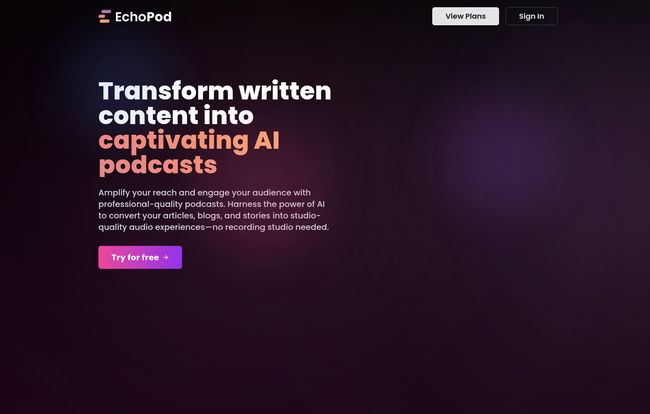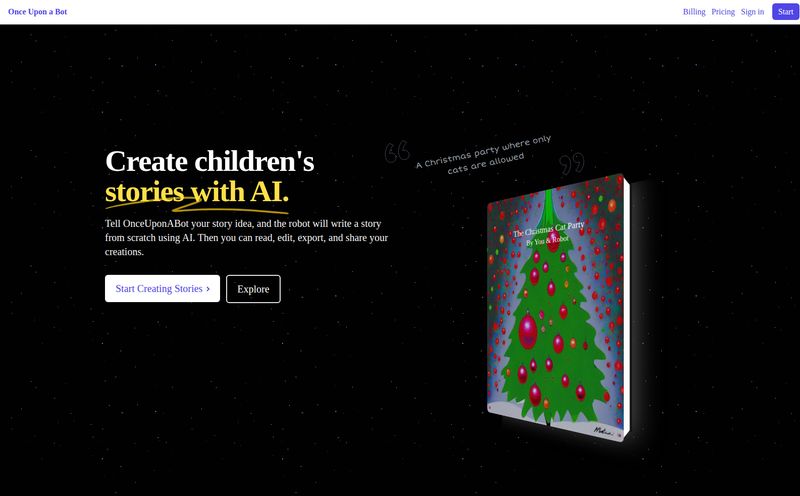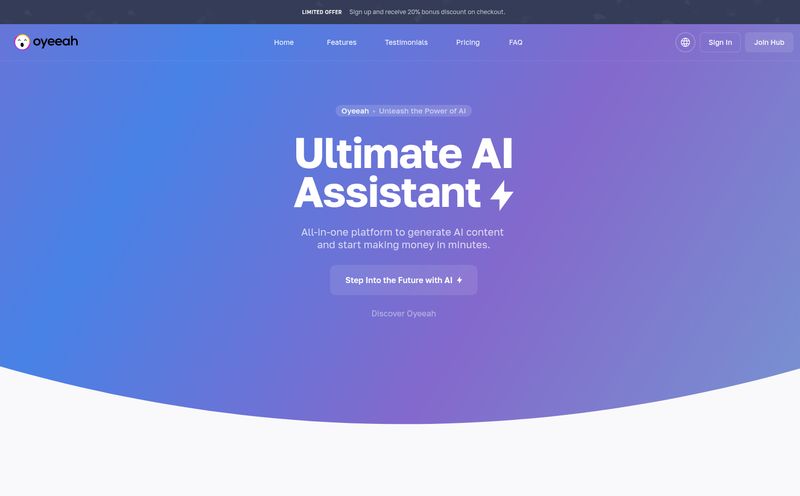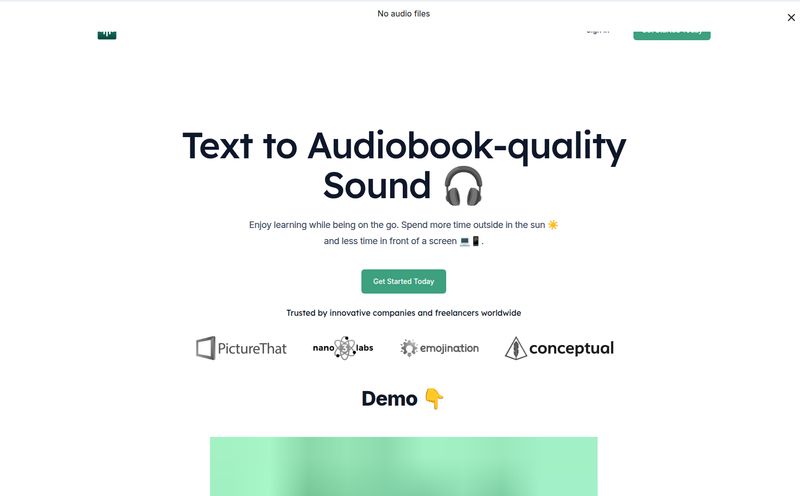The content creation hamster wheel is exhausting. You spend hours, maybe even days, crafting the perfect blog post. You research, you write, you edit, you find the perfect images, and you hit 'publish'. And then what? You start all over again for the next one. For years, we SEOs and marketers have been preaching the gospel of "repurpose your content," but honestly, who has the time?
I once tried to start a podcast to complement my blog. I bought a decent mic, learned the basics of Audacity, and recorded exactly two episodes. The editing, the mixing, the sheer time it took to make it sound… well, not terrible… was just too much. The dream died, and the mic is now a very expensive paperweight. So when I stumbled upon a tool called EchoPod, which claims to turn written content into 'captivating AI podcasts,' my cynical, battle-hardened marketer's heart skipped a beat. Could this be the shortcut I've always wanted? Or just another overhyped AI gimmick? I had to find out.
What Exactly is EchoPod? (And Why Should You Care?)
In a nutshell, EchoPod is a service that takes your articles, whitepapers, and blog posts and uses artificial intelligence to transform them into a fully produced audio experience. Think of it less as a simple text-to-speech reader and more like an AI sound engineer and voice actor rolled into one. You give it the script (your article), and it gives you back a ready-to-distribute podcast episode, complete with different voices and background music.
Why should you care? Because your audience is probably listening to podcasts right now. While they're commuting, at the gym, walking the dog… these are all moments where they can't read your blog, but they could be listening to it. Tapping into the audio world is a massive opportunity for traffic and brand building that most text-based creators are completely missing out on. EchoPod's entire pitch is built on bridging that gap without you having to buy that fancy mic I mentioned.

Visit EchoPod
The Alluring Promise of Effortless Podcasting
The biggest barrier to entry for podcasting isn't ideas; it's execution. The technical side is a huge pain. You need gear, you need quiet space, you need editing software, and most importantly, you need time. EchoPod's main value proposition is a direct assault on that barrier. It removes the entire production process from your plate.
But here’s the part that really got my attention. It’s not just reading your text aloud. According to them, the AI actually restructures the content for an optimal listening experience. This is a big deal. Reading and listening are two different cognitive functions. What works on the page can sound clunky and dry when spoken. If their AI can genuinely rewrite sentences for better flow and cadence, that's a game-changer. It’s the difference between a robotic dictation and a genuinely engaging piece of audio content.
A Closer Look at the Features That Matter
Okay, let's get into the nitty-gritty. A slick landing page is one thing, but what are you actually getting for your money? I dug into their plans and features to see what stands out.
From Written Word to Spoken Narrative
The core of the service is, of course, the transformation itself. You can submit content via email, and on the higher-tier plans, even via website integration or by just dropping in an external link. One of the most intriguing features, available on the Professional plan and up, is the choice between a 'Narrative' mode and a 'Discussion' mode. I'm picturing Narrative mode as a single, authoritative voice reading a post, perfect for deep-dive articles or whitepapers. The Discussion mode, though, is fascinating. It suggests the ability to use multiple voices, perhaps to create a conversational feel for a Q&A post or a scripted interview. That's a level of production value that would take significant effort to replicate manually.
The Sound of Your Brand
If every AI-generated podcast sounds the same, the advantage is lost. Customization is critical. EchoPod offers a selection of unique voices and background music tracks. The Basic plan is a bit limited, with 2 voices per language and 4 music tracks. It’s enough to get started. But the Professional plan bumps that up to 6 voices and 16 music options, which gives you much more room to find a sound that fits your brand's personality.
And then there's the Enterprise plan. This is where it gets really serious. They offer a custom AI voice clone. Imagine your company's blog being read in the voice of your CEO or a specific brand ambassador, perfectly replicated by AI for every new article. For a large corporation, that is an incredibly powerful branding tool. It's the kind of high-tech wizardry that used to be science fiction.
Getting Your Podcast Out There
Creating the audio file is only half the battle. You still need to get it onto platforms like Spotify, Apple Podcasts, and Google Podcasts. EchoPod handles this beautifully by providing an MP3 file and, more importantly, an RSS feed. For those not in the podcasting world, the RSS feed is the magic key. It’s what you submit to all the directories, and it automatically updates with every new episode you create. This is a non-negotiable feature for any serious podcasting tool, and they’ve nailed it. The higher plans even offer a full-service submission service, taking that last bit of admin work off your hands.
Let's Talk Money: A Breakdown of EchoPod's Pricing
Alright, this is where the rubber meets the road. This kind of tech isn't free, and the pricing structure will likely be the deciding factor for many. The plans are billed annually, so it's a commitment.
| Plan | Price (per month, billed annually) | Who It's For | Key Features |
|---|---|---|---|
| Basic | €100 | Solopreneurs or small businesses testing the audio waters. | 10 podcasts/month, 2 voices/lang, 4 music tracks, Narrative mode. |
| Professional | €250 | Serious content marketers and medium-sized businesses. | 25 podcasts/month, 6 voices/lang, 16 music tracks, Discussion mode, Processes external links. |
| Enterprise | Custom | Large organizations and established brands. | Custom voice cloning, custom music, full-service support. |
My take? The price isn't cheap, but you have to frame it correctly. What would it cost to hire a freelance voice actor and an audio editor for 10 or 25 episodes a month? I can tell you right now, it would be significantly more than €100 or €250. When you factor in the time saved, the pricing starts to make a lot of sense for businesses that are serious about their content strategy. One small thing to watch out for: pricing might be excluding VAT, so be sure to check that.
The Good, The Bad, and The "Coming Soon"
No tool is perfect. After going through everything, here’s my honest breakdown. The biggest pro is the sheer efficiency. It turns a multi-day production nightmare into a simple, automated workflow. The potential to create professional-sounding audio at this scale is a massive win.
On the flip side, the limitations of the Basic plan, especially the 2 voices, could be a sticking point. You're running the risk of your podcast sounding like someone else's if you don't upgrade. The biggest eyebrow-raiser for me was seeing that "Custom intro and outro" is a 'coming soon' feature on the Professional plan. That's a podcasting 101 element. It's a bit of a miss that it's not available from the get-go, but it does signal that the platform is still in active development, which is a good thing in the long run.
My Final Verdict from an SEO and Traffic Perspective
So, is EchoPod a worthwhile investment for someone focused on traffic and search rankings? I believe so, for several key reasons:
- Dwell Time and Engagement: Embedding an audio version of your article can significantly increase the time users spend on your page. This is a strong positive signal to Google.
- New Discovery Channels: By distributing your content as a podcast, you're creating brand new entry points. Someone might discover your brand on Spotify, then visit your website. It's a classic multi-channel marketing play. According to Edison Research's Infinite Dial report, podcast listenership continues to grow, so you're fishing in a very well-stocked pond.
- Enhanced Accessibility: This is a huge and often overlooked benefit. An audio version makes your content accessible to users with visual impairments or reading disabilities, broadening your audience and creating a better user experience for everyone.
Ultimately, this is content repurposing on steroids. You’re taking one asset—your well-researched article—and multiplying its reach and impact with minimal extra effort. That’s a smart SEO strategy.
Is EchoPod the Future of Your Blog?
So, what's the final word? EchoPod is an incredibly powerful and promising tool. It’s not for the casual blogger or the hobbyist. It’s a profesional tool with a professional price tag, aimed squarely at content marketers, publishers, and businesses who understand the value of audio. It solves a very real, very time-consuming problem in a clever way.
While I'm eager to see features like custom intros become standard, the core offering is solid. It represents a significant step towards a future where the line between written and spoken content blurs, making information more accessible and engaging for everyone. My old podcasting mic might be gathering dust, but thanks to tools like this, my blog's voice might just find its way onto the airwaves after all.
Frequently Asked Questions about EchoPod
- Can I use EchoPod for any language?
- Currently, their plans specify support for English and Dutch, which is in beta. The Enterprise plan offers custom solutions, which would likely include other languages, but for the standard plans, you're limited to those for now.
- Do I need my own podcast hosting service?
- No, you don't. EchoPod provides you with an RSS feed for each podcast you create. This is the feed you submit to platforms like Spotify and Apple Podcasts, and it's all you need to manage your distribution.
- Is the AI voice robotic?
- EchoPod claims to provide "professional-grade" and "studio-quality" audio. While all AI voices have some level of artificiality, the goal of modern platforms like this is to be as natural and human-like as possible. The best way to judge is to use their free trial and hear it for yourself.
- What is the difference between Narrative and Discussion mode?
- While not explicitly defined in detail, Narrative mode is most likely a single voice reading the content, ideal for standard articles. Discussion mode, a feature of the Professional plan, likely uses multiple AI voices to create a back-and-forth conversational style, which would be perfect for turning a written interview or a Q&A post into a more dynamic audio experience.
- Is EchoPod worth the monthly cost?
- This depends entirely on your content goals and budget. If you compare the monthly fee to the cost of hiring a voice actor and an audio editor for several episodes a month, EchoPod offers a significant potential return on investment, especially when you factor in the massive amount of time saved.



